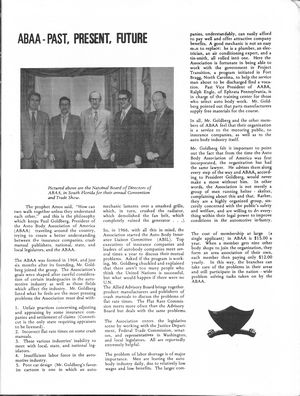|
By accessing or using The Crittenden Automotive Library™/CarsAndRacingStuff.com, you signify your agreement with the Terms of Use on our Legal Information page. Our Privacy Policy is also available there. |

ABAA - PAST, PRESENT, FUTURE
|
|---|
|
|
ABAA - PAST, PRESENT, FUTURE
Florida Automotive Journal
December 1970
 Pictured above are the National Board of Directors of ABAA, in South Florida for their annual Convention and Trade Show. Pictured above are the National Board of Directors of ABAA, in South Florida for their annual Convention and Trade Show.
|
The prophet Amos said, "How can two walk together unless they understand each other," and this is the philosophy which keeps Paul Goldberg, President of the Auto Body Association of America (ABAA) traveling around the country, trying to create a better understanding between the insurance companies, crash manual publishers, national, state, and local legislators, and the ABAA.
The ABAA was formed in 1964, and just six months after its founding, Mr. Goldberg joined the group. The Association's goals were shaped after careful consideration of certain inadequacies in the automotive industry as well as those fields which affect the industry. Mr. Goldberg listed what he feels are the most pressing problems the Association must deal with:
1. Unfair practices concerning adjusting and appraising by some insurance companies and settlement of claims (Connecticut is the only state requiring appraisers to be licensed).
2. Incorrect flat rate times on some crash manuals.
3. These various industries' inability to meet with local, state, and national legislators.
4. Insufficient labor force in the automotive industry.
5. Poor car design (Mr. Goldberg's favorite cartoon is one in which an auto mechanic laments over a smashed grille, which, in turn, crushed the radiator, which demolished the fan belt, which completely ruined the generator . . .).
So, in 1966, with all this in mind, the Association started the Auto Body Insurance Liaison Committee (ABIL). Top executives of insurance companies and leaders of autobody companies meet several times a year to discuss their mutual problems. Asked if the program is working, Me. Goldberg chuckled and examined that there aren't too many people who think the United Nations is successful, but what would happen if there were no U.N.
The Allied Advisory Board brings together product manufacturers and publishers of crash manuals to discuss the problems of flat rate times. The Flat Rate Commission meets more often than the Advisory Board but deals with the same problems.
The Association enters the legislative scene by working with the Justice Department, Federal Trade Commission, senators, and representatives in Washington, and local legislators. All are reportedly extremely helpful.
The problem of labor shortage is of major importance. Men are leaving the auto body industry daily, due to relatively low wages and low benefits. The larger companies, understandably, can easily afford to pay well and offer attractive company benefits. A good mechanic is not an easy man to replace; he is a plumber, an electrician, an air conditioning expert, and a tin-smith, all rolled into one. Here the Association is fortunate in being able to work with the government in Project Transition, a program initiated in Fort Bragg, North Carolina, to help the service man about to be discharged find a vocation. Past Vice President of ABAA, Ralph Engle, of Ephrata Pennsylvania, is in charge of the training center for those who select auto body work. Mr. Goldberg pointed out that parts manufacturers supply free materials for the course.
In all, Mr. Goldberg and the other members of ABAA feel that their organization is a service to the motoring public, to insurance companies, as well to the auto body industry itself.
Mr. Goldberg felt it important to point out the fact that from the time the Auto Body Association of America was first incorporated, the organization has had the same lawyer. He advises them along every step of the way and ABAA, according to President Goldberg, would never make a move without him. In other words, the Association is not merely a group of men running helter - skelter, complaining about this and that. Rather, they are a highly organized group, sincerely concerned with the public's safety and welfare, and are willing to do everything within their legal power to improve conditions in the automotive industry.
The cost of a membership at large (a single applicant) in ABAA is $15.00 a year. When a member gets nine other body shops to join the organization, they form an area association of their own, each member then paying only $12.00 yearly. In this way, the branches can take care of the problems in their areas and still participate in the nation - wide problem solving tasks taken on by the ABAA.

















 Pictured above are the National Board of Directors of ABAA, in South Florida for their annual Convention and Trade Show.
Pictured above are the National Board of Directors of ABAA, in South Florida for their annual Convention and Trade Show.
